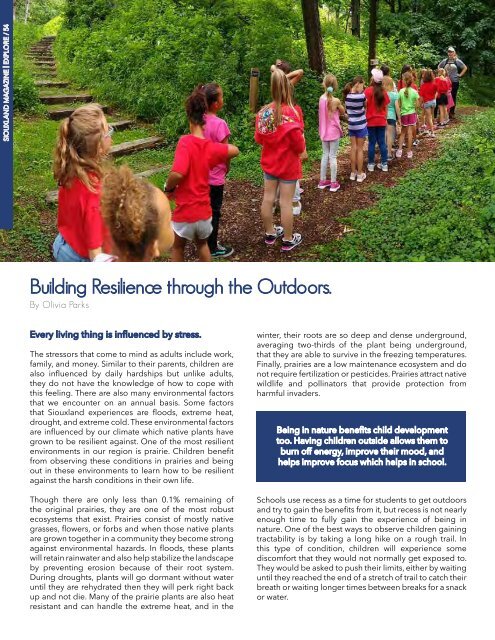Siouxland Magazine - Volume 1 Issue 4
You also want an ePaper? Increase the reach of your titles
YUMPU automatically turns print PDFs into web optimized ePapers that Google loves.
<strong>Siouxland</strong> <strong>Magazine</strong> | explore / 54<br />
Building Resilience through the Outdoors.<br />
By Olivia Parks<br />
Every living thing is influenced by stress.<br />
The stressors that come to mind as adults include work,<br />
family, and money. Similar to their parents, children are<br />
also influenced by daily hardships but unlike adults,<br />
they do not have the knowledge of how to cope with<br />
this feeling. There are also many environmental factors<br />
that we encounter on an annual basis. Some factors<br />
that <strong>Siouxland</strong> experiences are floods, extreme heat,<br />
drought, and extreme cold. These environmental factors<br />
are influenced by our climate which native plants have<br />
grown to be resilient against. One of the most resilient<br />
environments in our region is prairie. Children benefit<br />
from observing these conditions in prairies and being<br />
out in these environments to learn how to be resilient<br />
against the harsh conditions in their own life.<br />
Though there are only less than 0.1% remaining of<br />
the original prairies, they are one of the most robust<br />
ecosystems that exist. Prairies consist of mostly native<br />
grasses, flowers, or forbs and when those native plants<br />
are grown together in a community they become strong<br />
against environmental hazards. In floods, these plants<br />
will retain rainwater and also help stabilize the landscape<br />
by preventing erosion because of their root system.<br />
During droughts, plants will go dormant without water<br />
until they are rehydrated then they will perk right back<br />
up and not die. Many of the prairie plants are also heat<br />
resistant and can handle the extreme heat, and in the<br />
winter, their roots are so deep and dense underground,<br />
averaging two-thirds of the plant being underground,<br />
that they are able to survive in the freezing temperatures.<br />
Finally, prairies are a low maintenance ecosystem and do<br />
not require fertilization or pesticides. Prairies attract native<br />
wildlife and pollinators that provide protection from<br />
harmful invaders.<br />
Being in nature benefits child development<br />
too. Having children outside allows them to<br />
burn off energy, improve their mood, and<br />
helps improve focus which helps in school.<br />
Schools use recess as a time for students to get outdoors<br />
and try to gain the benefits from it, but recess is not nearly<br />
enough time to fully gain the experience of being in<br />
nature. One of the best ways to observe children gaining<br />
tractability is by taking a long hike on a rough trail. In<br />
this type of condition, children will experience some<br />
discomfort that they would not normally get exposed to.<br />
They would be asked to push their limits, either by waiting<br />
until they reached the end of a stretch of trail to catch their<br />
breath or waiting longer times between breaks for a snack<br />
or water.


















